RBSE Solutions for Class 8 Maths Chapter 4 Practice Geometry Intext Questions
Rajasthan Board RBSE Solutions for Class 8 Maths Chapter 4 Practice Geometry Intext Questions Textbook Exercise Questions and Answers.
Rajasthan Board RBSE Solutions for Class 8 Maths in Hindi Medium & English Medium are part of RBSE Solutions for Class 8. Students can also read RBSE Class 8 Maths Important Questions for exam preparation. Students can also go through RBSE Class 8 Maths Notes to understand and remember the concepts easily. Practicing the class 8 maths chapter 6 try these solutions will help students analyse their level of preparation.
RBSE Class 8 Maths Solutions Chapter 4 Practice Geometry Roots Intext Questions
(Think, Discuss and Write Page No:58)
Question 1.
Arshad has five measurements of a quadrilateral ABCD. These are AB = 5 cm, ∠A = 50°, AC = 4 cm, BD = 5 cm and AD = 6 cm. Can he construct a unique quadrilateral? Give reasons for your answer.
Answer:
The quadrilateral ABCD with the given data cannot be constructed because of the following reasons:
(i) If he takes diagonal BD first, then he is able to construct one ∆ABD but the second ∆BCD to complete the quadrilateral ABCD cannot be drawn as its only one side BD is known.
(ii) If he takes the diagonal AC first, then the construction of ∆ACP and ∆ABC is not possible as the data are insufficient.

(Page No: 60)
Question (i) We saw that 5 measurements of a quadrilateral can determine a quadrilateral uniquely. Do you think any five measurements of the quadrilateral can do this? .
Answer:
It is necessary to have at least the knowledge of five parts to be able to construct quadrilateral uniquely
- When four sides and one diagonal are given.
- When two diagonals and three sides are given.
- When two adjacent sides and three angles are given.
- When three sides and two included angles are given.
- When four sides and one angle are given.
Question (ii) Can you draw a parallelogram BATS where BA = 5 cm, AT = 6 cm and AS = 6.5 cm? Why?
Answer:
Yes, (he parallelogram BATS with the given data c&n be drawn as it can be divided into two triangles BAS and SAT.
Question (iii)
Can you draw a rhombus ZEAL where ZE = 3.5 cm, diagonal EL = 5 cm? Why?
Answer:
Yes, the rhombus ZEAL with the given data can be drawn as it can be divided into two triangles ZEL and LEA.
Question (iv)
A student attempted to draw a quadrilateral PLAY where PL = 3 cm, LA = 4 cm, AY = 4.5 cm, PY = 2 cm and LY = 6 cm, but could not draw it. What is the reason?
[Hint : Discuss it using a rough sketch].
Answer:
A rough sketch is given here according to given data. We observe that PY + PL ≯ YL (2 + 3 ≯ 6) Y
so construction of ∆PLY is not possible. Thus the 2 quadrilateral PLAY cannot be drawn.
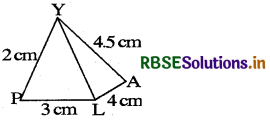

(Page No: 62)
Question 1.
In the above example 2, can we draw the quadrilateral by drawing ∆ ABD first and then find the fourth point C?
Answer:
Since the measurement of AB is not given.
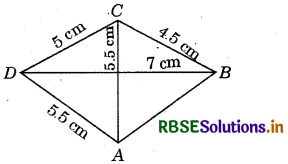
We cannot locate the point B. Thus, the quadrilateral cannot be drawn by drawing ∆ABD first. Therefore, fourth point C cannot be found by this way.
Question 2.
Can you construct a quadrilateral PQRS with PQ = 3 cm, RS = 3 cm, PS = 7.5 cm, PR = 8 cm and SQ = 4 cm? Justify your answer.
Answer:
We draw a rough sketch of quadrilateral PQRS. Quadrilateral PQRS cannot be drawn as we cannot draw the ∆QSP since
SQ + QP ≯ SP
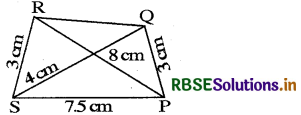
(Page No: 64)
Question 1.
Can you construct the above quadrilateral MIST if we have 100° at M instead of 75°?
Answer:
Yes, the quadrilateral MIST can be constructed with ∠M = 100° instead of 75°.
Question 2.
Can you construct the quadrilateral PLAN if PL = 6 cm, LA = 9.5 cm, ∠P = 75°, ∠L = 150° and ∠A = 140°? (Hint : Recall angle-sum property).
Answer:
Since ∠P = 75°, ∠L = 150° and ∠A = 140°
∴ ∠P + ∠L + ∠A = 75°+ 150° + 140° = 365°
Therefore, the construction of the quadrilateral PLAN is not possible.

Question 3.
In a parallelogram, the lengths of adjacent sides are known. Do we still need measures of the angles to construct as in the example 3 of text book?
Answer:
It is necessary to have at least the knowledge of five parts to be able to construct quadrilateral uniquely. But only two adjacent sides of a parallelogram are known here and no angle is given. Therefore the construction of parallelogram is not possible here.
(Page No: 66)
Question 1.
In the above example 4 of textbook, we first drew BC. Instead, what could have been the other starting points?
Answer:
We could have first drawn AB or CD.
Question 2.
We used some five measurements to draw quadrilaterals so far. Can there be different sets of five measurements (other than seen so far) to draw a quadrilateral? The following problems may help you in answering the question.
(i) Quadrilateral ABCD with AB = 5 cm, BC = 5.5 cm, CD = 4 cm, AD = 6 cm and ∠B = 80°.
(ii) Quadrilateral PQRS with PQ = 4.5 cm, ∠P = 70°, ∠Q = 100°, ∠R = 80° and ∠S = 110°.
Construct a few more examples of your own to find sufficiency/insufficiency of the data for construction of a quadrilateral.
Answer:
(i) This data gives the case of construction of quadrilateral when four sides and one angle is given.
(ii) In this case, quadrilateral can not be drawn. Here is a case which enables us to draw a quadrilateral.
Ex. construct a quadrilateral ABCD where AB = 8 cm, BC = 4.5 cm, CD = 4 cm, ZB = 60° and AB || CD

(Try These Page No: 67)
Question 1.
How will you construct a rectangle PQRS if you know only the lengths PQ and QR?
Answer:
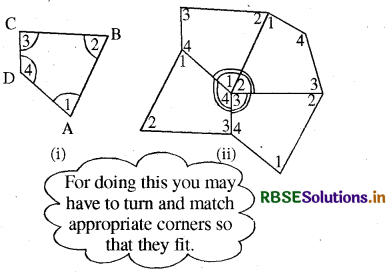
Here,
only two adjacent sides of the rectangle are given. Other properties of rectangle are:
(i) its opposite sides are equal.
(ii) each angle measures 90°.
So, first we draw PQ and then construct ∠PQR = 90° such that QR (= given length). Also we construct ∠SPQ = 90° such that PS = QR. Join SR to obtain the required rectangle PQRS.

Question 2.
Construct the kite EASY if AY = 8 cm, EY = 4 cm and SY = 6 cm (see figure). Which properties of the kite did you use in the process?
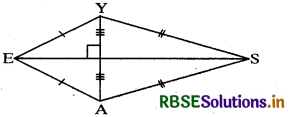
Answer:
In the process of construction of the kite, we use the property than a kite has two pairs of equal adjacent sides and unequal sides. We draw a line PQ of any reasonable length. We take any point on it. At L, construction RU ⊥ PQ is shown.
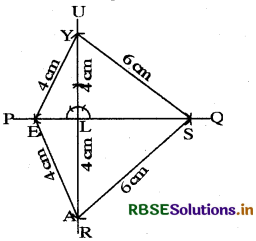
Along LR and LU, cut off LA = LY = 4 cm with A as centre, we draw an arc of radius 4 cm. With Y as centre, we draw another arc of radius 4 cm Intersecting the previous arc at E. We join EA and EY. With A as centre and radius 6 cm, we draw an arc on the other side of RS. With Y as centre, we draw another arc of radius 6 cm intersecting the previous arc at S. Join AS and YS. Thus we obtain the required kite EASY.

- RBSE Solutions for Class 8 Maths Chapter 11 क्षेत्रमिति Ex 11.3
- RBSE Solutions for Class 8 Maths Chapter 2 एक चर वाले रैखिक समीकरण Ex 2.4
- RBSE Solutions for Class 8 Maths Chapter 6 Square and Square Roots Intext Questions
- RBSE Solutions for Class 8 Maths Chapter 11 क्षेत्रमिति Ex 11.2
- RBSE Solutions for Class 8 Maths Chapter 6 वर्ग और वर्गमूल Ex 6.2
- RBSE Solutions for Class 8 Maths Chapter 3 चतुर्भुजों को समझना Ex 3.2
- RBSE Solutions for Class 8 Maths Chapter 5 Data Handling Intext Questions
- RBSE Solutions for Class 8 Maths Chapter 11 Mensuration Intext Questions
- RBSE Solutions for Class 8 Maths Chapter 2 एक चर वाले रैखिक समीकरण Ex 2.5
- RBSE Solutions for Class 8 Maths Chapter 8 Comparing Quantities Intext Questions
- RBSE Solutions for Class 8 Maths Chapter 7 घन और घनमूल Ex 7.2